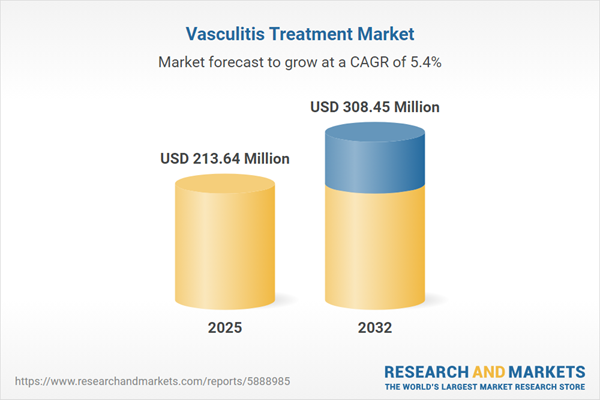Speak directly to the analyst to clarify any post sales queries you may have.
Senior decision-makers navigating the vasculitis treatment market are challenged by rapid innovation, shifting patient needs, and greater market complexity. Staying ahead requires clear, data-driven insights to inform commercial and operational strategies while maintaining alignment with evolving clinical standards.
Market Snapshot: Vasculitis Treatment Market Overview
The global vasculitis treatment market demonstrates steady growth, expanding from USD 202.92 million in 2024 to an estimated USD 213.64 million by 2025 and projected to reach USD 308.45 million in 2032, reflecting a compound annual growth rate of 5.37% during this period.
This increase is driven by ongoing investment in breakthrough therapies, enhanced clinical awareness, and a concentrated focus on patient-centric care models. Both leading pharmaceutical organizations and new market entrants are reshaping research and operational approaches, reacting to changing care delivery standards and evolving regulatory requirements.Scope & Segmentation of the Vasculitis Treatment Market
This report offers in-depth segmentation and actionable intelligence for pharmaceutical leaders, supporting targeted decisions across commercial, clinical, and supply-chain strategies. By analyzing technological advancements and geographic variation, decision-makers can optimize patient outcomes, identify high-potential opportunities, and address specific care requirements.
- Treatment Types: Biologic agents, corticosteroids, immunosuppressive drugs, and plasma exchange address diverse patient profiles, offering multiple options to improve disease management and support individualized care plans.
- Disease Categories: ANCA-associated vasculitis, Behçet disease, giant cell arteritis, IgA vasculitis, and Takayasu arteritis each provide unique avenues for market segmentation. This enables commercial teams to tailor messaging and engagement strategies to distinct patient populations.
- Administration Routes: Intravenous, oral, and subcutaneous therapies allow clinicians flexibility in care delivery across inpatient and outpatient environments, promoting better patient experience and adherence.
- End Users: Ambulatory care centers, specialty clinics, hospitals, and therapy centers serve as critical access points to support integrated care pathways and enable coordinated patient management.
- Distribution Channels: Hospital, online, and retail pharmacies drive compliant therapeutics access and broaden the reach of treatment options to end users through regulated distribution networks.
- Geographic Coverage: Americas, Europe, Middle East and Africa, and Asia-Pacific markets are reviewed to highlight how regional policy and demographic trends shape therapy adoption and guide localized strategy development.
- Key Players: Roche, ChemoCentryx, AbbVie, Johnson & Johnson, Bristol-Myers Squibb, Amgen, UCB, Novartis, Pfizer, and Sanofi are profiled in detail. The analysis centers on their R&D strategies, advancements in commercialization, and initiatives to improve access and address evolving clinical demands.
Key Takeaways for Senior Decision-Makers
- Biologic and targeted treatments are changing disease management paradigms, enabling teams to advance personalized care pathways for both acute and chronic cases.
- Regulatory landscapes remain highly dynamic, requiring agile compliance strategies and robust planning to achieve market longevity and successful product launches.
- The adoption of digital health technologies supports real-time disease monitoring, enhancing patient management and allowing more proactive intervention by care teams.
- Strategic collaborations among pharmaceutical companies, technology partners, and academia drive the creation of novel delivery solutions and accelerate development of combination therapies, enriching market competitiveness.
- Differences in reimbursement policies and healthcare frameworks across regions make adaptive market entry planning essential, ensuring broad patient access and minimizing legal or operational complications.
Tariff Impact: Navigating 2025 United States Regulatory Adjustments
Forthcoming U.S. tariff adjustments are anticipated to affect vasculitis therapy pricing and distribution channels. Senior leaders should evaluate domestic production approaches, review supplier agreements, and institute robust tariff management and compliance processes. Strong supply chain partnerships are advised to maintain reliable product access and protect patients during regulatory transitions.
Methodology & Data Sources
This report deploys a scenario-driven analytical model that synthesizes current published research, regulatory review, and extensive clinical expertise, complemented by specialist interviews. The resulting insights offer a foundational resource for biopharmaceutical decision-makers aiming to prioritize strategic investments.
Why This Report Matters
- Uncovers actionable strategies to support sustainable growth and optimize resources through evolving market dynamics.
- Enables senior leaders to respond confidently to regulatory and clinical changes with evidence-based recommendations.
- Reinforces organizational readiness by guiding effective risk management in response to shifting policy and reimbursement landscapes.
Conclusion
Embracing a flexible, data-driven approach strengthens market positioning. Leverage these insights to refine operational strategies and prepare your organization for continuous change within the vasculitis treatment sector.
Additional Product Information:
- Purchase of this report includes 1 year online access with quarterly updates.
- This report can be updated on request. Please contact our Customer Experience team using the Ask a Question widget on our website.
Table of Contents
3. Executive Summary
4. Market Overview
7. Cumulative Impact of Artificial Intelligence 2025
Companies Mentioned
The companies profiled in this Vasculitis Treatment market report include:- F. Hoffmann-La Roche Ltd
- ChemoCentryx, Inc.
- AbbVie Inc.
- Johnson & Johnson
- Bristol-Myers Squibb Company
- Amgen Inc.
- UCB S.A.
- Novartis AG
- Pfizer Inc.
- Sanofi S.A.
Table Information
| Report Attribute | Details |
|---|---|
| No. of Pages | 191 |
| Published | November 2025 |
| Forecast Period | 2025 - 2032 |
| Estimated Market Value ( USD | $ 213.64 Million |
| Forecasted Market Value ( USD | $ 308.45 Million |
| Compound Annual Growth Rate | 5.3% |
| Regions Covered | Global |
| No. of Companies Mentioned | 11 |









